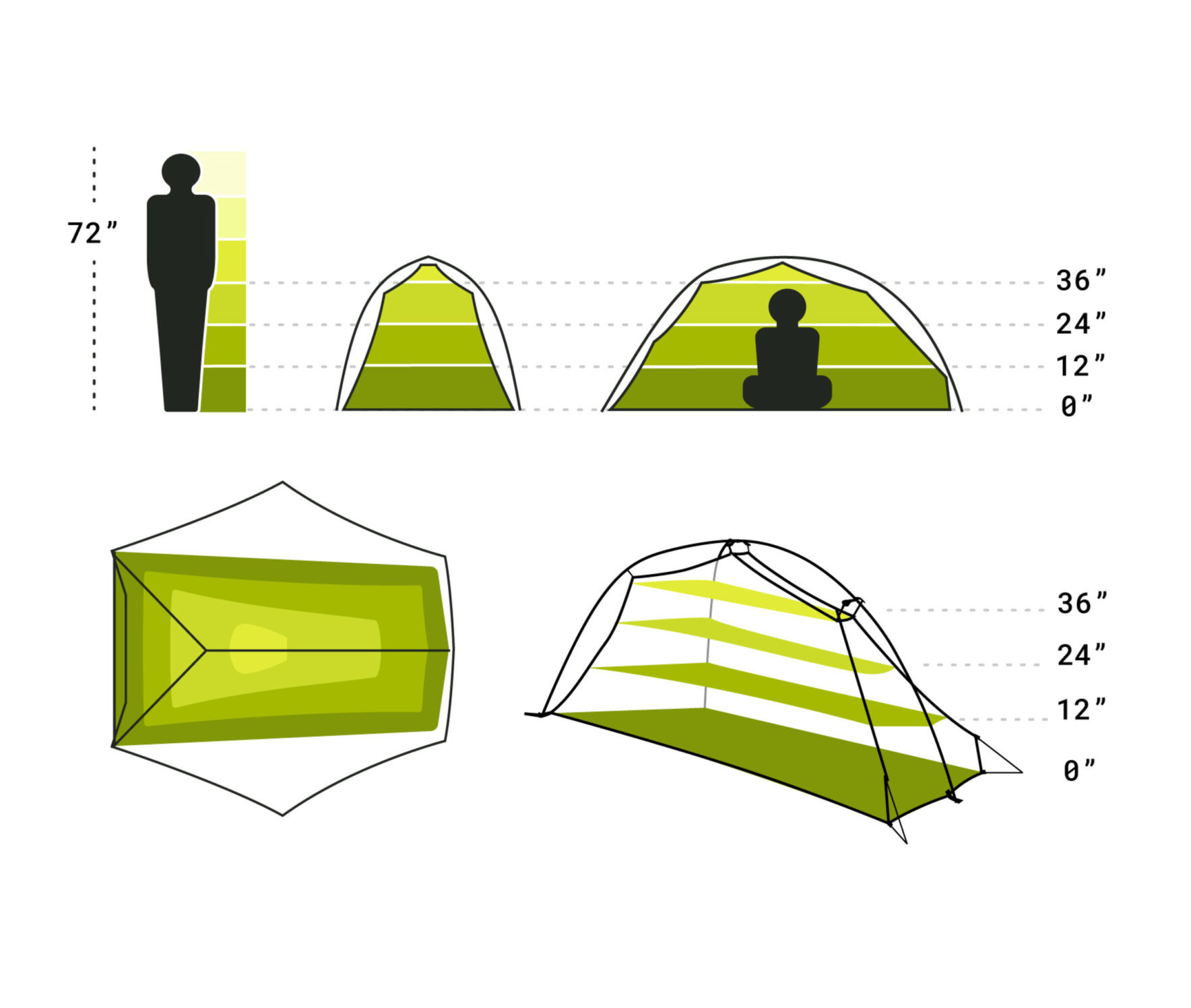Help
Fit My Tent measurements uses two informative and revealing measurements:
- Sleeping length: The length across the sleeping area of the tent, measured one foot off the ground, which will be comfortable for a sleeper using an inflatable sleeping pad and a sleeping bag.
- Headroom: The available headroom while sitting, measured three feet off the ground, in a diamond shape. These are the headroom length and headroom width measurements.

Here are some interesting tent comparisons. These are not value judgements about which tent is better. This is just a reminder that usable space can vary between similar tents. The important thing is to pick the right tent for you.
- Nemo Hornet 2p vs. Big Agnes Copper Spur HV UL2: One of these is a true 2-person tent, the other is a large single person tent.
- X-Mid 2p Tarp vs. Big Agnes Copper Spur HV UL2: Both are 2-person tents but the trade-off needs to be made between a free-standing tent and a trekking-pole tent.
- GG The One vs. REI Flash Air 1: Both are light-weight trekking-pole tents, but one has massively more headroom.
- 9x7 A-Frame (120cm) vs. MLD Grace Solo Tarp (120cm): Both pitch in an A-Frame. The trade-off is made between a larger and more flexible tarp vs. a tighter-pitching and lighter tarp.
- Generic Pyramid vs Generic Dome: Both have identical usable area but one is likely lighter and the other has a smaller footprint.
Don't see a tent on this site that you'd like to buy? Contact its manufacturer and tell them about us!
Own a tent that you don't see on this site? Check out the Measurements page then contact /u/hoofit on Reddit.
FAQ
How big of a tent do I need to be comfortable?This is a very personal question. There is no single answer for all hikers. If you'd like to learn more, you can read this article for a lot more information: Backpacking shelters for the BIG & tall, and those who sprawwwl.
I am a professional basket player and I can sleep comfortably in a suitcase. Your recommendations are worthless!Our recommendations are meant to be conservative suggestions that will work for most people. There are urban legends of tall people comfortably sleeping in the smallest of tents. That might work for them. It might work for you. Our recommendations are only a starting point.
You're missing measurements for a tent I want to buy. Why don't you have it?This is a new project. It relies on contributions from the backpacking community. Don't see a tent on this site that you'd like to buy? Contact its manufacturer and tell them about us! Own a tent that you don't see on this site? Check out the Measurements page then contact /u/hoofit on Reddit.
Some of these measurements make no sense. The usable area is bigger than the tent, or smaller than I'd expect. What gives?The outline of the tents are taken from manufacturer specifications. Real tents rarely rarely match the specifications. Consider the outline to be a rough idea. The usable area (shaded green) is based on real-life measurements by hand of real tents. The usable area is affected by catenary cuts, sagging fabric, struts, tent poles, and a number of other factors.
I sleep diagonally in a 2-person tent. How much extra sleeping length do I get?You will get about 3" of extra sleeping length for most lightweight 2-person tents. This does not sound like much but it allows someone who is 6'1" to fit in a tent that would otherwise fit someone who is 5'10".
What about tents with panel pullouts by the head and foot?You will get about 2-4" of sleeping length by using panel pullouts. This may not seem like much, but it allows someone who is 6'3" to fit in a tent that would normally fit someone who is 6'0". All measurements include the use of panel pullouts for tents that offer them.
What about modular tarp systems like the Deschutes and X-Mid?We recommend looking at the usable room of the outer wall first. This will have the biggest effect on the usable area (don't touch the outer wall!) as well as the perceived roominess. Next look at the inner net you plan to use. Understand that it will likely be smaller than the equivalent inner of a traditional poled tent. This isn't a big deal because the inner will be low tension. Touching it isn't a big deal -- unless it would bother you personally.
For the X-mid tents we average the usable room of the inner and outer.
Have you thought about measuring it a different way? Wouldn't it be great if you added measurement X?This measurement system uses the simplest possible measurements that still have predictive power. Previous versions of this system included more measurements like total usable floor area. Various measurements were tried such as treating the floor as a hexagon, or the headroom as a rectangle. Those were harder to measure, more inconsistent, and provided diminishing returns over this simple system. Anyone can measure their tent with this system using a ruler, a yard stick, and a tape measure.
More data is always a good thing. Nemo gives us amazing tent cross sections as seen in the diagram to the right. All companies should provide this data. We need better standards. The simpler measurements we use are still helpful in the meantime. |

|
It depends on the tent. Free-standing (poled) tent measurements are quite accurate. These measurements are accurate within an inch. Trekking pole tent pitches can vary quite a bit depending on the pole height, tie-out length, and tension. Their measurements can vary by 1 to 2 inches. Tarp pitches can very drastically.
What are estimated measurements?A handful of tents like the Tarptent Protrail, Zpacks Altaplex, and Zpacks Duplex use estimated measurements. These tents are not measured by hand. They are similar enough to other tents that we feel comfortable providing estimated usable measurements.